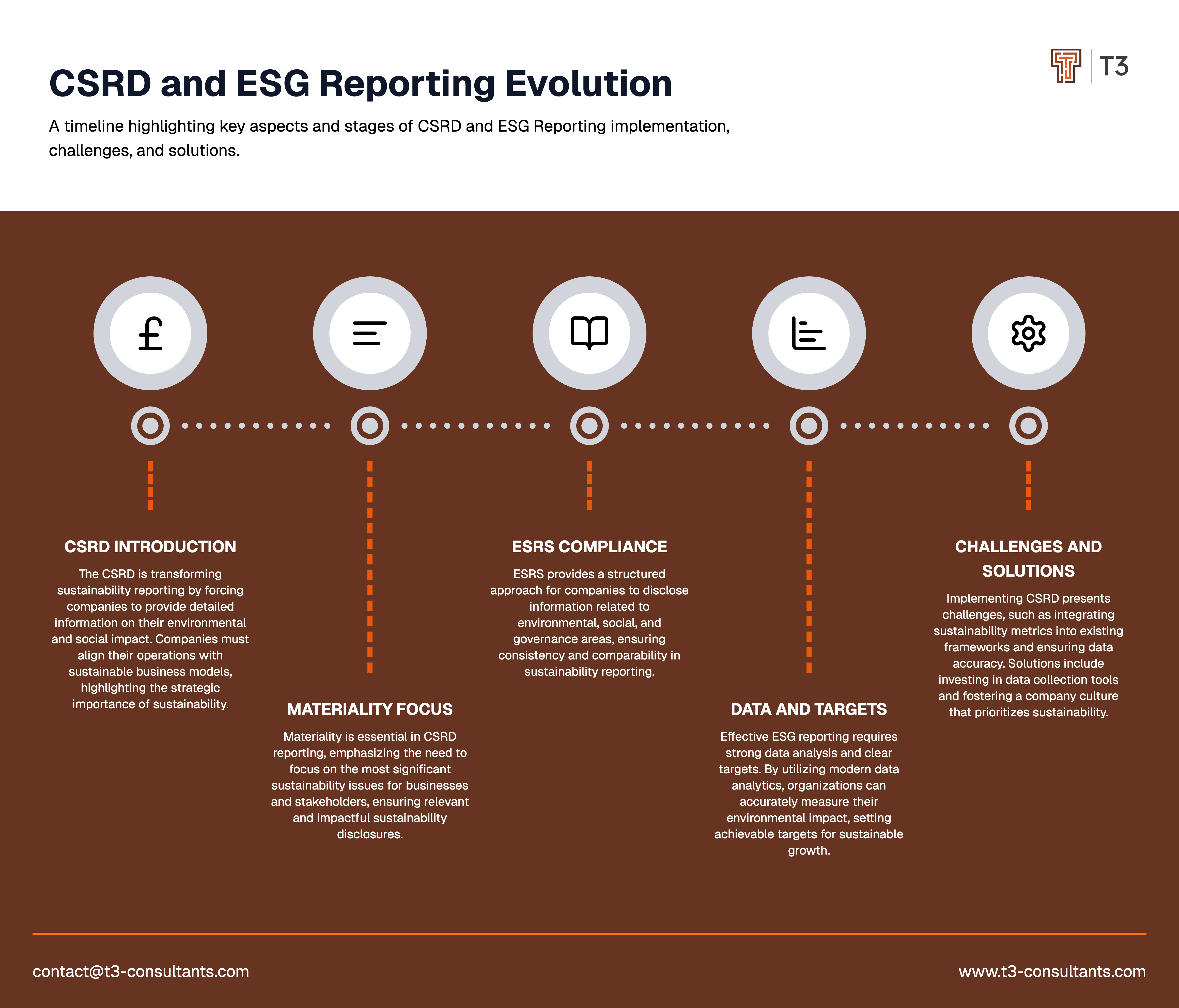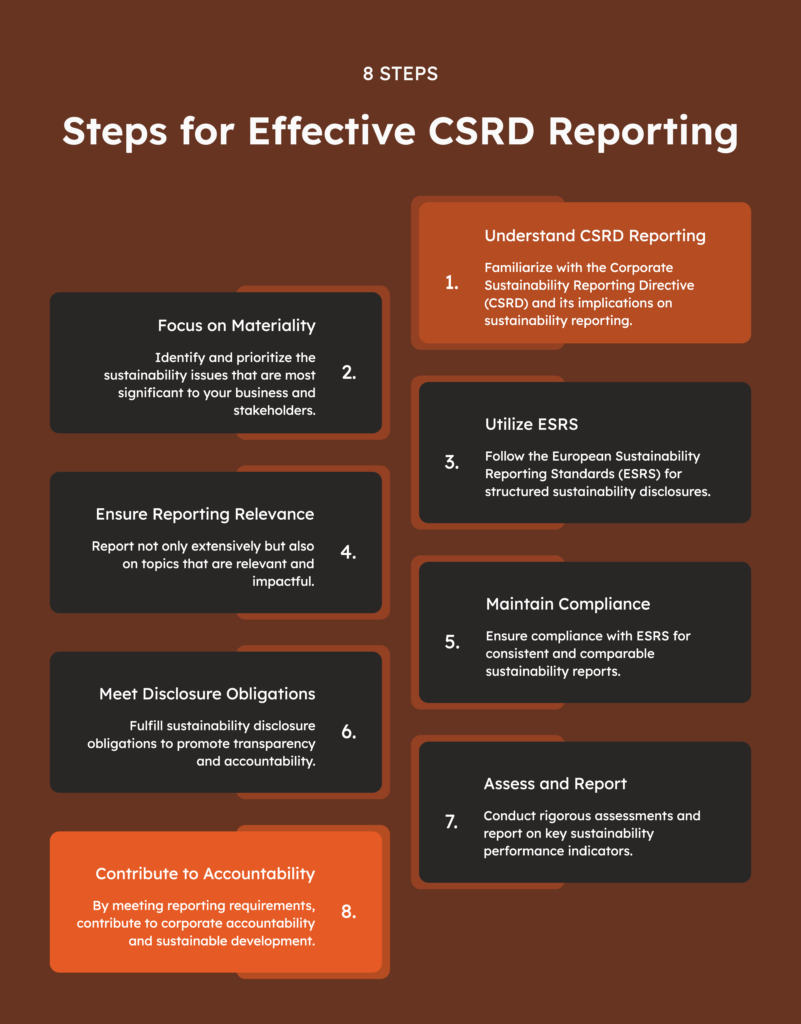
CSRD Reporting Training: Master ESG Reporting Techniques
Overview of CSRD and ESG Reporting
CSRD is a game changer in sustainability reporting, with a focus on transparency and accountability in companies. Going beyond the NFRD, the CSRD will require companies to report granular information about the effect of their activities on the environment, climate, social, and employee-related matters. It signals the strategic relevance of sustainability to companies and forces them to align operations with sustainable business models.
ESG reporting standards serve as a compass for sustainable business conduct, assisting companies in assessing and communicating performance on key sustainability issues. Compliance with ESG frameworks enables identification of risks and opportunities, enhancing competitiveness and trust of stakeholders. In a world of growing stakeholder awareness, companies understand that sustainability is now more than a compliance requirement. It is a key success factor in the long run. By embedding CSRD and ESG standards, companies can shape a transparent and sustainable future that meets the increased expectations of investors, regulators, and society.
Key Elements in CSRD Reporting
The new Corporate Sustainability Reporting Directive (CSRD) represents a major change in how companies report on their sustainability activities. Knowing key components of CSRD reporting is vital for companies looking to maintain transparency and compliance. Two main components—materiality and the European Sustainability Reporting Standards (ESRS)—are critical for creating useful sustainability disclosure reports.
Materiality in CSRD Reporting
The key principle of effective CSRD reporting is materiality. This requires organizations to identify and focus on those sustainability issues that matter most to their business and stakeholders. It ensures that the reported information is not merely extensive but also relevant and impactful. By determining the materiality of various topics, companies can prioritize the issues that significantly affect the company itself or are most important to stakeholders. This tailored approach enhances the credibility and relevance of sustainability disclosures, in line with the CSRD’s aim to encourage transparent reporting.
ESRS Compliance
Central to the standardization of sustainability information disclosure under the CSRD is the European Sustainability Reporting Standards (ESRS). These standards offer a structured outline for companies on what to disclose and how to disclose it. Covering environmental, social, and governance areas, the ESRS suits all sustainability dimensions effectively. Compliance with the ESRS equips organizations to issue consistent and comparable reports meeting the needs of all stakeholders, from investors to regulators.
Sustainability Disclosure Obligations
The sustainability disclosure obligations of the CSRD promote transparency and accountability. Companies must reveal in-depth information about their environmental impacts, social responsibilities, and governance strategies. The obligations encourage companies to assess their sustainability performance rigorously and report on key performance indicators showcasing their dedication to sustainable development. By fulfilling these disclosure obligations, companies not only meet legal requirements but also contribute to the wider cause of corporate accountability and sustainable expansion.
Mastering CSRD Skills: Training Courses and Certifications
Gaining expertise in the evolving field of Corporate Sustainability and Responsible Development (CSRD) is essential. Training courses are available to meet the needs of both beginners and professionals who wish to excel in this dynamic sector. These courses offer a complete educational experience, covering the latest concepts and best practices in the field of CSRD.
Courses are offered online and through in-person workshops to accommodate all learning styles and schedules. Participants have the flexibility to work through course material at their own pace and engage with interactive content and expert trainers. Proper impactful training allows individuals to develop a full understanding of the methodologies in CSRD and their implementation in real-life scenarios.
Achieving CSRD certification is rewarding. It acts as a formal acknowledgment that allows certified professionals to stand out in a competitive job market. Certification confirms your knowledge and dedication towards sustainability issues and can lead to increased job prospects and leadership roles in the industry. CSRD certification also provides organizations confidence that their sustainability standards are being adhered to, in turn enhancing their company image and corporate trust.
Implementing ESG Reporting within Organizations
The implementation of ESG (Environmental, Social, Corporate Governance) reporting in organizations is of the utmost importance in today’s business world. The utilization of ESG frameworks is a common method to effectively incorporate these forms of disclosures into organizations, whereby standards such as the TCFD (Task Force on Climate-Related Financial Disclosures) and GRI (Global Reporting Initiative) present protocol to heighten responsibility and transparency to sustainability.
Steps to ESG Framework Integration
- Understanding Requirements: It is vital to completely grasp the fundamentals of the TCFD and GRI standards, as they provide a clear step-by-step approach to the disclosing of climate-related risks (in the case of TCFD) and broader sustainability impacts (through the lens of GRI) necessary for a thorough approach to ESG reporting.
- Assessment and Gap Analysis: An organization must perform a gap analysis to identify where its current ESG policies and execution stand relative to these frameworks. This involves assessing current methods of data collection and reporting to find areas that require enhancement.
- Stakeholder Engagement: Inclusivity of stakeholders in this process confirms that ESG objectives are in line with the overall objectives of the business and meet stakeholder expectations, offering valuable insights and prioritization in those ESG frameworks which an organization must focus on predominantly.
- Incorporating into Business Strategy: ESG integration in the overarching business strategy guarantees that sustainability mechanics are similarly connected to long-term growth, establishing terms that may be feasible and measured on metrics provided through data analysis.

The Importance of Data Analysis and Target Setting
Strong data analysis and clear target setting lie at the crux of proficient ESG reporting. An organization’s ability to gather and interpret sustainability data may have an influence on the precision of its ESG reports, with the use of modern techniques in data analytics heightening the precision in the measurement of environmental footprints and governance standards.
Furthermore, after collecting data and analyzing it, the establishment of clear and achievable targets remains a priority. Such targets, be it in reducing carbon footprints or in social governance, provide a path to sustainable growth. With specific, quantifiable targets, organizations are capable of tracing the progress made and making necessary adjustments in strategies following new data.
Challenges and Solutions in CSRD Adoption
As companies move towards compliance with the CSRD, the challenges they face may pose a risk to their reputation if not properly addressed. Among the challenges that companies commonly face, one of the most critical is the integration of comprehensive sustainability metrics into existing reporting frameworks. Many companies struggle with the heavy lifting involved in adapting to the rigorous demands of collecting and reporting data, which can put severe administrative pressure on the organization.
Another challenge is the accuracy of reported data. With stakeholders increasingly informed and vigilant, any discrepancies between reported and actual performance could cause significant reputational harm to the company. Companies also encounter internal resistance as employees and senior management recalibrate existing practices, and policies to place a greater emphasis on sustainability.
To mitigate these challenges and protect their reputation, companies can consider several solutions. The investment in strong mechanisms for data collection and sustainability management software can greatly simplify reporting, thereby facilitating more accurate and efficient data gathering. Such a digital solution will not only increase the accuracy of data but will guarantee that the organization is compliant with CSRD obligations.
Companies can further invest in education and training programs internally. By upskilling employees through training on sustainability, companies can create a culture that embraces and welcomes changes for sustainability. This cultural change is needed to tackle any resistance from within and create a longer-lasting commitment towards long-term sustainability objectives.
Additionally, transparency is pivotal in protecting a company’s reputation. Through open disclosures of achievements and shortfalls to stakeholders, the company can cultivate trust and showcase a genuine commitment to sustainability. This is inclusive of setting transparent and quantifiable targets, and providing regular progress updates, which will increase the confidence of stakeholders, and in turn, the reputation of the company.
In conclusion, while the requirements of the CSRD pose significant challenges to companies, proactive measures and open communication can help to effectively manage risks, preserve reputation, and deliver lasting success.
